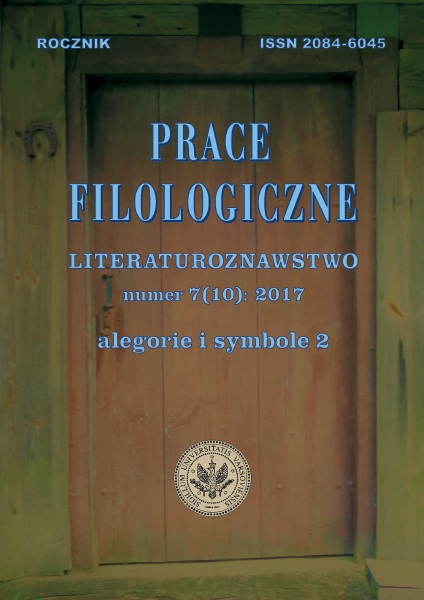Między aktem świadomości a wypowiedzią. Technika strumienia świadomości jako metafora sztuki
Between the act of consciousness and the act of speech. Stream of consciousness technique as a metaphor of art
Author(s): Magdalena SaganiakSubject(s): Studies of Literature
Published by: Wydział Polonistyki Uniwersytetu Warszawskiego
Keywords: strumień świadomości; stream of consciousness; symbol; Julian Przyboś
Summary/Abstract: The subject of the article is an aesthetic experience in literary arts illustrated with the example of stream of consciousness used in poetic prose by Julian Przyboś in his cycle of poetry entitled {Pióro z ognia} ({A Feather Made of Fire}, 1937). There are several kinds of the stream of consciousness technique, but the most interesting one is a direct written record of a character's thought process which usually takes the form of an interior monologue. Such record of the multitudinous thoughts and feelings which pass through the mind cannot by treated as a speech act because of the lack of an apparent organized form and because of the fact that the "speaker" is not addressing an audience or a third person. However this equivalent of thoughts can be treated in an aesthetic manner, on a special meta-level which is possible in aesthetic communication. Therefore, the following questions arise: is it possible to take someone’s own stream of consciousness as a subject of that kind of aesthetic experience and then to treat everything forming part of consciousness as inspiration for certain aesthetic interest? Could it be similar to ‘progressive universal poetry’ described by Friedrich Schlegel? Could a well-known definition of aesthetic experience by Stanisław Ossowski be a proper description of such attitude? In Ossowski 's concept, the most important features of aestheticexperience are as follows: separating from our scientific interests and practical concerns, a certain ‘disinterested’ attitude and a play which allows different perception of time i.e. ‘living in the moment’. If we adopt that approach to the modern stream of consciousness technique it may transpire that the most important aspect of any aesthetic experience is not a certain feature of a given piece of art but a certain activity of consciousness which assumes a particular position to itself and finds pleasure in the feeling of its own power and activity. Tematem artykułu jest doświadczenie estetyczne w literaturze, badane na przykładzie techniki strumienia świadomości, zastosowanej między innymi w prozie poetyckiej Juliana Przybosia w cyklu Pióro z ognia (1937). Wśród kilku wyróżnionych przez Roberta Humphreya odmian tej techniki literackiej najciekawszy wydaje się bezpośredni zapis strumienia świadomości, często przybierający postać bezpośredniego monologu wewnętrznego. Zapis taki w ścisłym sensie nie jest wypowiedzią, ponieważ nie jest uporządkowany i nie zakłada ukierunkowania na odbiorcę, a jednak może być odbierany przez czytelnika w postawie estetycznej, na pewnym metapoziomie, możliwym w komunikacji estetycznej. Pojawiają się zatem pytania, czy możliwe jest także, by uczynić własny strumień świadomości przedmiotem tak zorganizowanego przeżycia estetycznego i doświadczać wszystkiego, co wchodzi w pole świadomości, na sposób estetyczny. Czy podobnie powstaje postulowana przez Fryderyka Schlegla progresywna poezja uniwersalna? Czy adekwatnym obrazem tego rodzaju aktywności byłaby definicja doświadczenia estetycznego, podana przez Stanisława Ossowskiego, który za najważniejsze wyróżniki tego doświadczenia uważał względną izolację przedmiotu sztuki (osiąganą najczęściej przez iluzję), wyzwolenie z zainteresowania celem użytkowym i swobodną grę, w której urzeczywistnia się inne odczucie czasu: "życie chwilą". Gdyby zastosować to wyjaśnienie do opisu techniki strumienia świadomości, okazałoby się, że najważniejszym aspektem doświadczenia estetycznego nie jest jakakolwiek cecha przedmiotu sztuki, lecz sam specyficzny ruch świadomości, która zmienia pozycję względem siebie samej i znajduje przyjemność w przeżyciu swego ruchu i mocy.
Journal: Prace Filologiczne. Literaturoznawstwo [PFLIT]
- Issue Year: 2017
- Issue No: 7 (10)
- Page Range: 141-156
- Page Count: 16
- Language: Polish

